
Today we hear the Gospel of the poor widow who only gave two coins to the treasury while everyone around her seemed to be giving much more. This theme can be seen in the Old Testament as well. If we look at the story of Cain and Abel we see that God is happy with Abel’s offering because he gave the most important part of his flock whereas Cain gave the minimum amount he was willing to offer.
These verses have me thinking about the biblical concept of stewardship. We have probably heard a million times that stewardship is not just about money but then we hear about the campaigns that both dioceses and parishes put on and so it is hard to separate the concepts.
I think a helpful way to think about stewardship is not to downplay the money aspect but instead to realize that everything is a gift. Think about it for a second, if you are taking your next breath, that means that God is actively thinking about you, holding you in existence, and allowing you to live your life to the full. If God stopped thinking about us for even a second we would cease to exist.
So whether it is money, our gifts and talents, services we provide, or just our presence, all things have been given to us as a gift to be shared. In St. John Paul II’s work, Theology of the Body, he speaks about the concept of the spousal meaning of the body. He talks about the idea that all of us have a spousal meaning to ourselves that essentially has two elements. The first is that we are made with intrinsic dignity in and of ourselves. The second is that we were made to give. In fact, the more we give the more we realize who we truly are.
This is true because we were made by a God who is pure gift. He grants us gifts and graces every day so that we might more fully realize who we are and how we are meant to serve and love our fellow man. The Gospel for today gets right to the heart of this matter. God does not have a checklist in heaven to see who is giving the most of their time, talent, and treasure. It is not a numbers game for Him. What He is concerned with is that we are giving our all and genuinely serving Him and those He has put into our lives.
Imagine a world where we all take the biblical principle of stewardship seriously and first realize how good we are and then from there realize our inner call to be a gift. My prayer for all of us today is that we can realize this and put it into action. Let’s be more like the poor widow who gives fully of what she has been given. Whether what we have to give is big or small, let’s give it our all.
From all of us here at Diocesan, God bless!
Daily Reading
Second Sunday of Advent
Reading 1 Isaiah 11:1-10 On that day, a shoot shall sprout from the stump of Jesse, and from his roots a bud shall blossom. The spirit of the LORD shall…
Saint of the Day
St. Ambrose
St. Ambrose
Feast date: Dec 07
Today the Catholic Church celebrates the memory of St. Ambrose, the brilliant Bishop of Milan who influenced St. Augustine’s conversion and was named a Doctor of the Church. Like Augustine himself, the older Ambrose, born around 340, was a highly educated man who sought to harmonize Greek and Roman intellectual culture with the Catholic faith. Trained in literature, law, and rhetoric, he eventually became the governor of Liguria and Emilia, with headquarters at Milan. He manifested his intellectual gifts in defense of Christian doctrine even before his baptism. While Ambrose was serving as governor, a bishop named Auxentius was leading the diocese. Although he was an excellent public speaker with a forceful personality, Auxentius also followed the heresy of Arius, which denied the divinity of Christ. Although the Council of Nicaea had reasserted the traditional teaching on Jesus’ deity, many educated members of the Church – including, at one time, a majority of the world’s bishops – looked to Arianism as a more sophisticated and cosmopolitan version of Christianity. Bishop Auxentius became notorious for forcing clergy throughout the region to accept Arian creeds. At the time of Auxentius’ death, Ambrose had not yet even been baptized. But his deep understanding and love of the traditional faith were already clear to the faithful of Milan. They considered him the most logical choice to succeed Auxentius, even though he was still just a catechumen. With the help of Emperor Valentinan II, who ruled the Western Roman Empire at the time, a mob of Milanese Catholics virtually forced Ambrose to become their bishop against his own will. Eight days after his baptism, Ambrose received episcopal consecration on Dec. 7, 374. The date would eventually become his liturgical feast. Bishop Ambrose did not disappoint those who had clamored for his appointment and consecration. He began his ministry by giving everything he owned to the poor and to the Church. He looked to the writings of Greek theologians like St. Basil for help in explaining the Church’s traditional teachings to the people during times of doctrinal confusion. Like the fathers of the Eastern Church, Ambrose drew from the intellectual reserves of pre-Christian philosophy and literature to make the faith more comprehensible to his hearers. This harmony of faith with other sources of knowledge served to attract, among others, the young professor Aurelius Augustinus – a man Ambrose taught and baptized, whom history knows as St. Augustine of Hippo. Ambrose himself lived simply, wrote prolifically, and celebrated Mass each day. He found time to counsel an amazing range of public officials, pagan inquirers, confused Catholics and penitent sinners. His popularity, in fact, served to keep at bay those who would have preferred to force him from the diocese, including the Western Empress Justina and a group of her advisers, who sought to rid the West of adherence to the Nicene Creed, pushing instead for strict Arianism. Ambrose heroically refused her attempts to impose heretical bishops in Italy, along with her efforts to seize churches in the name of Arianism. Ambrose also displayed remarkable courage when he publicly denied communion to the Emperor Theodosius, who had ordered the massacre of 7,000 citizens in Thessalonica leading to his excommunication by Ambrose. The chastened emperor took Ambrose’s rebuke to heart, publicly repenting of the massacre and doing penance for the murders. “Nor was there afterwards a day on which he did not grieve for his mistake,” Ambrose himself noted when he spoke at the emperor’s funeral. The rebuke spurred a profound change in Emperor Theodosius. He reconciled himself with the Church and the bishop, who attended to the emperor on his deathbed. St. Ambrose died in 397. His 23 years of diligent service had turned a deeply troubled diocese into an exemplary outpost for the faith. His writings remained an important point of reference for the Church, well into the medieval era and beyond. St. Ambrose has been named one of the “holy fathers” of the Church, whose teaching all bishops should “in every way follow.”
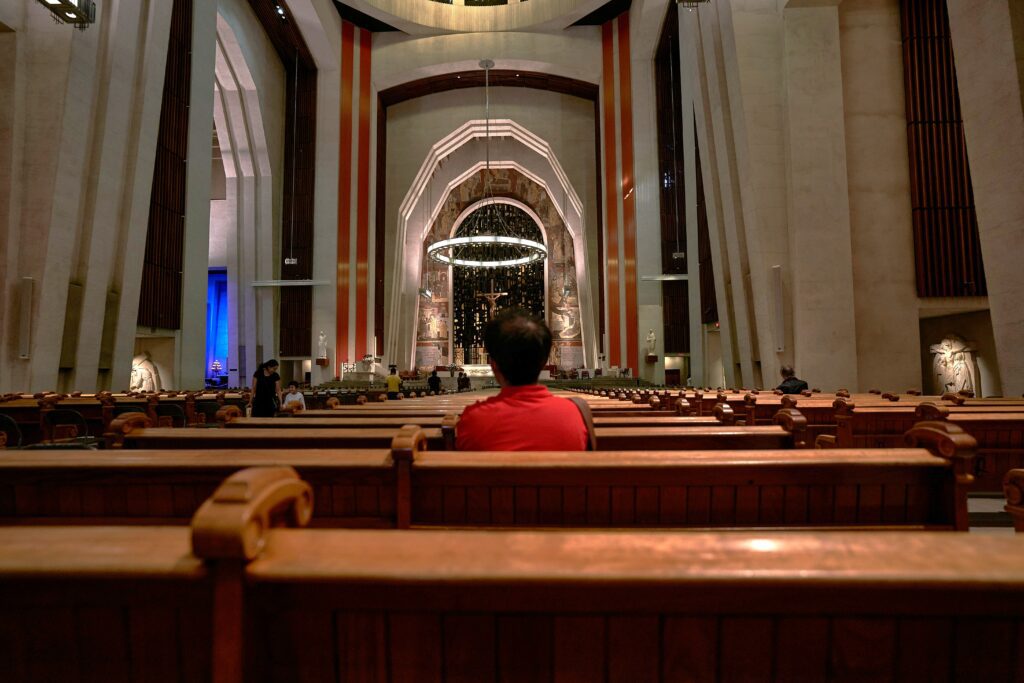
Have you ever been falsely accused and felt you did nothing to deserve the blame? In today’s Gospel, one criminal rebuked another, saying, “Have you no fear of God, for you are subject to the same condemnation? And indeed, we have been condemned justly…but this man has done nothing criminal.” What reaction do you have when faced with false accusations? Anger? Denial? Frustration? Hopelessness? Acceptance? In this Gospel, Jesus and the redeemed criminal provide a great example of how to handle adversity when a situation hits you hard.
Jesus was nearing the end of His time here on earth, yet He focused on saving one more soul before reuniting with the Father. This selfless act shows us that regardless of life’s circumstances, there will always be someone there to help us through. That Someone is Jesus Christ. The redeemed criminal knew he would be together with Jesus in heaven because of His words. Then he spent time in sacred silence, letting the love and mercy of God wash over him.
When do we experience sacred silence? We see several examples within the Mass. During the Penitential Act, we silently acknowledge our sins. Immediately after that, the Priest says, “Let us pray,” and the momentary silence serves as a doorway for us to speak to the Lord and for Him to fill us with His love and mercy. After the homily, we also take a moment of silence. I always ask the Lord to fill my heart and soul with the wisdom from the Gospel and the priest’s words.
Do you experience sacred silence in your daily life? How does it feel within you, and how do you accept it? Another example that comes to mind is sitting with Jesus in Adoration. When I spend an hour in silence it fills me with love, understanding, and a genuine connection with Him. I realize, though, that many times I miss the opportunity for silence and quickly move on to the next action I need to take.
Sacred silence is there when I realize that Jesus is always present, no matter what. He wants to tell me it will be alright, and to rely on Him and His will. It is when our hearts are united with His in a moment of pure love and there’s a peace that fills us. We cannot go wrong when we choose to spend time in sacred silence.
Daily Reading
Second Sunday of Advent
Reading 1 Isaiah 11:1-10 On that day, a shoot shall sprout from the stump of Jesse, and from his roots a bud shall blossom. The spirit of the LORD shall…
Saint of the Day
St. Ambrose
St. Ambrose
Feast date: Dec 07
Today the Catholic Church celebrates the memory of St. Ambrose, the brilliant Bishop of Milan who influenced St. Augustine’s conversion and was named a Doctor of the Church. Like Augustine himself, the older Ambrose, born around 340, was a highly educated man who sought to harmonize Greek and Roman intellectual culture with the Catholic faith. Trained in literature, law, and rhetoric, he eventually became the governor of Liguria and Emilia, with headquarters at Milan. He manifested his intellectual gifts in defense of Christian doctrine even before his baptism. While Ambrose was serving as governor, a bishop named Auxentius was leading the diocese. Although he was an excellent public speaker with a forceful personality, Auxentius also followed the heresy of Arius, which denied the divinity of Christ. Although the Council of Nicaea had reasserted the traditional teaching on Jesus’ deity, many educated members of the Church – including, at one time, a majority of the world’s bishops – looked to Arianism as a more sophisticated and cosmopolitan version of Christianity. Bishop Auxentius became notorious for forcing clergy throughout the region to accept Arian creeds. At the time of Auxentius’ death, Ambrose had not yet even been baptized. But his deep understanding and love of the traditional faith were already clear to the faithful of Milan. They considered him the most logical choice to succeed Auxentius, even though he was still just a catechumen. With the help of Emperor Valentinan II, who ruled the Western Roman Empire at the time, a mob of Milanese Catholics virtually forced Ambrose to become their bishop against his own will. Eight days after his baptism, Ambrose received episcopal consecration on Dec. 7, 374. The date would eventually become his liturgical feast. Bishop Ambrose did not disappoint those who had clamored for his appointment and consecration. He began his ministry by giving everything he owned to the poor and to the Church. He looked to the writings of Greek theologians like St. Basil for help in explaining the Church’s traditional teachings to the people during times of doctrinal confusion. Like the fathers of the Eastern Church, Ambrose drew from the intellectual reserves of pre-Christian philosophy and literature to make the faith more comprehensible to his hearers. This harmony of faith with other sources of knowledge served to attract, among others, the young professor Aurelius Augustinus – a man Ambrose taught and baptized, whom history knows as St. Augustine of Hippo. Ambrose himself lived simply, wrote prolifically, and celebrated Mass each day. He found time to counsel an amazing range of public officials, pagan inquirers, confused Catholics and penitent sinners. His popularity, in fact, served to keep at bay those who would have preferred to force him from the diocese, including the Western Empress Justina and a group of her advisers, who sought to rid the West of adherence to the Nicene Creed, pushing instead for strict Arianism. Ambrose heroically refused her attempts to impose heretical bishops in Italy, along with her efforts to seize churches in the name of Arianism. Ambrose also displayed remarkable courage when he publicly denied communion to the Emperor Theodosius, who had ordered the massacre of 7,000 citizens in Thessalonica leading to his excommunication by Ambrose. The chastened emperor took Ambrose’s rebuke to heart, publicly repenting of the massacre and doing penance for the murders. “Nor was there afterwards a day on which he did not grieve for his mistake,” Ambrose himself noted when he spoke at the emperor’s funeral. The rebuke spurred a profound change in Emperor Theodosius. He reconciled himself with the Church and the bishop, who attended to the emperor on his deathbed. St. Ambrose died in 397. His 23 years of diligent service had turned a deeply troubled diocese into an exemplary outpost for the faith. His writings remained an important point of reference for the Church, well into the medieval era and beyond. St. Ambrose has been named one of the “holy fathers” of the Church, whose teaching all bishops should “in every way follow.”
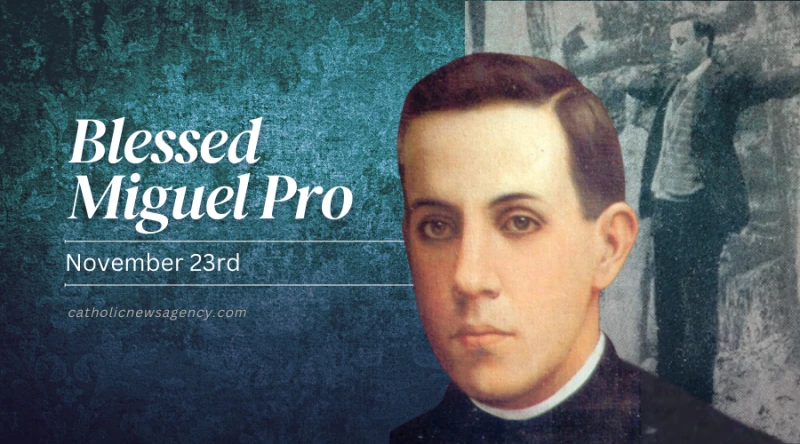
Blessed Miguel Pro Juarez
Feast date: Nov 23
Born in Guadalupe on January 13, 1891, Miguel Pro Juarez was one of 11 children. Miguel was, from an early age, intensely spiritual and equally intense in his mischievousness, frequently exasperating his family with his humor and practical jokes. As a child he had a daring precociousness that sometimes went too far, tossing him into near death accidents and illnesses. Miguel was particularly close to his older sister, and after she entered a cloistered convent he began to discern his own vocation, leading him to enter the Jesuit novitiate in El Llano, Michoacan at the age of 20. He studied in Mexico until 1914 when a tidal wave of governmental anti-Catholicism crashed down upon Mexico, forcing the order to flee to Los Gates, California. He then taught in Nicaragua from 1919 until 1922.
By the time Fr. Pro was ordained a priest in Enghien, Belgium in 1925, the political situation in Mexico had deteriorated: all Catholic churches were closed, bishops, priests, and religious were rounded up for deportation or imprisonment, and those caught trying to elude capture were shot. The celebration of the sacraments was punishable by imprisonment or death, and the Church was driven underground. Fr. Pro received permission from his superiors to return to Mexico incognito and to carry on his ministry undercover. Fr. Pro slipped into Mexico City and immediately began celebrating Mass and distributing the sacraments, often under imminent threat of discovery by a police force charged with the task of ferreting out hidden pockets of Catholicism. He became known throughout the city as the undercover priest who would show up in the middle of the night dressed as a beggar or a street sweeper to baptize infants, hear confessions, distribute Communion, or perform marriages. Several times, disguised as a policeman, he slipped unnoticed into the police headquarters itself to bring the sacraments to Catholic prisoners before their execution. Using clandestine meeting places, a wardrobe of disguises and coded messages to the underground Catholics, Fr. Pro carried on his priestly work for the Mexican faithful under his care.
A failed attempt in November 1927 to assassinate the President of Mexico which only wounded him provided the state with a pretext for arresting Fr. Pro with his brothers Humberto and Roberto. They were put in jail and held without trial for ten days, accused of the attempted assassination. On July 17, 1928, President Calles ordered Fr. Pro to be executed, ostensibly for his role in the assassination plot, but in reality for his defiance of the laws banning Catholicism. As Fr. Pro walked from his cell to the prison courtyard, he blessed the firing squad and then knelt and prayed silently for a few moments. Refusing a blindfold, he stood, faced the firing squad, and with a crucifix in one hand and a rosary in the other, he held his arms outstretched in the form of a cross and in a loud, clear voice cried out, “May God have mercy on you! May God bless you! Lord, Thou knowest that I am innocent! With all my heart I forgive my enemies!” As the soldiers lifted their rifles, he exclaimed in a loud voice, “Viva Cristo Rey!” – “Long live Christ the King!” A volley rang out and Fr. Pro fell to the ground riddled with bullets. A solider stepped up and discharged his rifle at point blank range into the priest’s temple. 30,000 people attended his funeral procession. Fr. Miguel Pro was beatified on September 25, 1988 by Pope John Paul II.
Fr. Pro used his natural gifts of intense determination and courage, seen throughout all parts of his life, to further the kingdom of God. Modern Catholics may follow Fr. Pro by taking courage and using their natural talents and gifts as God asks of them.
Daily Reading
Second Sunday of Advent
Reading 1 Isaiah 11:1-10 On that day, a shoot shall sprout from the stump of Jesse, and from his roots a bud shall blossom. The spirit of the LORD shall…
Daily Meditation
Prepare the Way of the Lord
Click here for daily readings I remember going to Mass at my parish during Advent and hearing Father sing “Prepare Ye the Way of the Lord” (from the musical Godspell)…
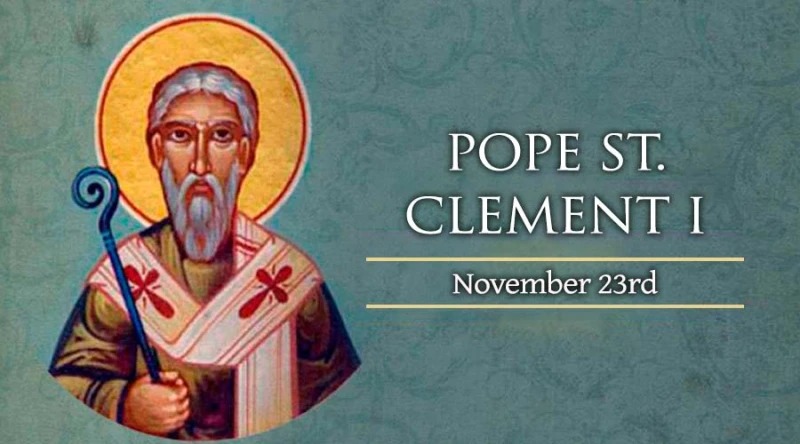
Pope St. Clement I
Feast date: Nov 23
On Nov. 23 Roman Catholics remember the fourth Pope, St. Clement I, a disciple of the apostles who inherited the authority of St. Peter in the first century. Eastern Catholics celebrate his feast on Nov. 25.
The details of Clement’s life, before his conversion and even afterward, are largely unknown. Some aspects of his writings have led scholars to believe that the fourth Pope either came from a Jewish background, or had converted to Judaism earlier in life before entering the Catholic Church.
Tradition suggests that Clement was the son of a Roman named Faustinus, and that he joined the Church in Rome during its early years through the preaching of Saint Peter or Saint Paul. He went on to share in the missionary journeys of the apostles, and may even have assisted the first Pope in running the Church on a local level.
After the deaths of St. Peter’s first two successors, the canonized Popes Linus and Cletus, Clement took up St. Peter’s position of primacy in the Church around the year 90. One of his most important tasks, during nearly 10 years as Pope, was to resolve serious problems in the Church of Corinth, which St. Paul had also struggled to discipline.
Clement’s own letter to the Corinthians, though not part of the biblical canon, offers an important look at the role of authority and charity in the early Church. Its introduction suggests that Pope Clement composed it while his own local Church faced persecution from the Roman Emperor Domitian.
In the letter, the Pope describes how the Corinthians had once been “distinguished by humility,” being “in no respect puffed up with pride” and “more willing to give than to receive.” But in time, “the worthless rose up against the honored, those of no reputation against such as were renowned, the foolish against the wise, the young against those advanced in years.”
“Let us give up vain and fruitless cares, and approach to the glorious and venerable rule of our holy calling,” Pope Clement wrote in his call to repentance. “Let us attend to what is good, pleasing, and acceptable in the sight of him who formed us.”
Order and discipline, he noted, are at least as important in the Church as they are in the rest of creation, where the powers of nature follow God’s decrees. The Pope also warned the Corinthians to follow “those who cultivate peace with godliness,” rather than “those who hypocritically profess to desire it.”
The Church Clement headed was one that honored tradition and right order as fundamentals of its life.
“It behooves us to do all things in order, which the Lord has commanded us to perform at stated times,” he told the Corinthians. God, he said, “has enjoined offerings and service to be performed … not thoughtlessly or irregularly, but at the appointed times and hours.”
“Where and by whom (God) desires these things to be done, he himself has fixed by his own supreme will, in order that all things being piously done according to his good pleasure, may be acceptable to him.”
The fourth Pope’s writings reveal much about the early Church, but little about his own life. According to one later account, he died in exile during the reign of the Emperor Trajan, who purportedly banished Clement to Crimea (near modern Ukraine) and had him killed in retaliation for evangelizing the local people. In 868 the Greek missionary St. Cyril claimed to have recovered St. Clement’s bones.
St. Clement I probably died around the year 100. He is among the saints mentioned in the Western Church’s most traditional Eucharistic prayer, the Roman Canon.
Daily Reading
Second Sunday of Advent
Reading 1 Isaiah 11:1-10 On that day, a shoot shall sprout from the stump of Jesse, and from his roots a bud shall blossom. The spirit of the LORD shall…
Daily Meditation
Prepare the Way of the Lord
Click here for daily readings I remember going to Mass at my parish during Advent and hearing Father sing “Prepare Ye the Way of the Lord” (from the musical Godspell)…
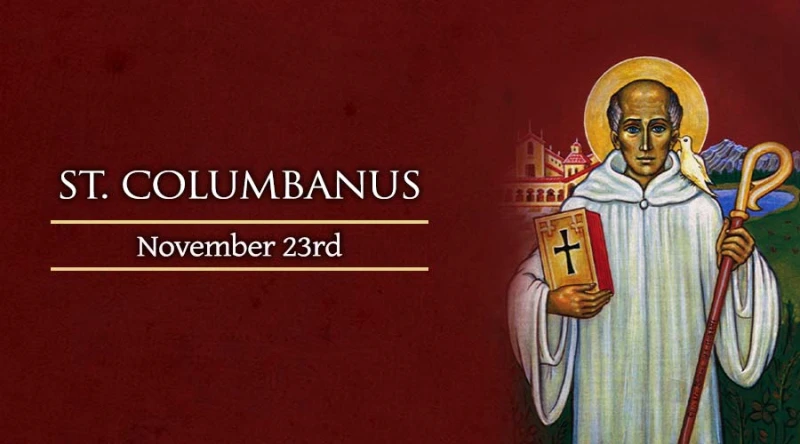
St. Columbanus
Feast date: Nov 23
An originator of Ireland’s unique monastic tradition, who went on to serve as a missionary to continental Europe during the early Middle Ages, the abbot Saint Columbanus – also known as St. Columban – is honored by the Catholic Church on Nov. 23.
Despite their similar names and biographies, St. Columbanus is not the same person as Saint Columba of Iona, another monk from Ireland who spread the faith abroad and lived during the same time period.
In a June 2008 general audience on St. Columbanus, Pope Benedict XVI said he was “a man of great culture” who also “proved rich in gifts of grace.” The Pope recalled him as “a tireless builder of monasteries as well as an intransigent penitential preacher who spent every ounce of his energy on nurturing the Christian roots of Europe which was coming into existence.”
“With his spiritual energy, with his faith, with his love for God and neighbor,” St. Columbanus “truly became one of the Fathers of Europe.” According to Pope Benedict, the course of the Irish monk’s life “shows us even today the roots from which our Europe can be reborn.”
Born during 543 in the southeastern Irish region of Leinster, Columbanus was well-educated from his early years. Handsome in appearance, he was tempted by women and was eventually advised by a nun to follow her example and flee from temptation by embracing monasticism. His mother disapproved of this intention, but his will prevailed even when she tried to prevent him from leaving home.
The aspiring monk studied initially with Abbot Sinell of Cluaninis, before moving on to a monastery headed by the abbot later canonized as Saint Comgall. It was under his direction, in the Abbey of Bangor in County Down, that Columbanus formally embraced the monastic calling, as one of a growing number of monks drawn to the Bangor community’s ascetic rigor and intellectual vitality.
Though Columbanus was known as a dedicated monk and scholar, around the year 583 he felt called to undertake foreign missionary work. Initially denied permission by the abbot, he was eventually allowed to depart with a band of twelve men, with whom he sailed to Britain before reaching France around 585. There, they found the Church suffering from barbarian invasions and internal corruption.
Received with favor by King Gontram of Burgundy, Columbanus and his companions founded a monastery in an abandoned Roman fortress. Despite its remote location in the mountains, the community became a popular pilgrimage site, and also attracted so many monastic vocations that two new monasteries had to be formed to accommodate them.
These monastic communities remained under Columbanus’ authority, and their rules of life reflected the Irish tradition in which he had been formed. Meanwhile, as they expanded, the abbot himself sought greater solitude, spending periods of time in a hermitage and communicating with the monks through an intermediary.
As heirs to the Irish monastic tradition, Columbanus and his monks ran into differences with the bishops in France, partly over the calculation of the date of Easter. He also met with opposition from within the French royal family, because of his insistence that King Thierry should not live with a woman outside of wedlock. He had been urged to do so by his grandmother Queen Brunehild, who thought a royal marriage would threaten her own power.
Columbanus’ moral stand for marriage led first to his imprisonment, from which he escaped. But the king and his grandmother had him driven out of France by force, and they separated him from his monks by insisting that only those from Ireland could accompany him into exile. This group traveled and evangelized in present-day Germany, though political circumstances eventually forced them to cross the Alps into northern Italy.
Welcomed by the ruling Lombards, Columbanus nonetheless found the Italian Church troubled by heresy and schism. The monk wrote against the Arian heresy (which claimed that Christ was not God but only a highly exalted creature), and asked Pope Saint Boniface IV to help restore the unity of the Church in the region. Columbanus himself was involved in a theological dispute with Pope Boniface, but he remained “bound to the Chair of Peter” and acknowledged the Pope’s authority.
Having received a grant of land from the Lombard king, Columbanus founded his last monastery in the town of Bobbio during 614. Although St. Columbanus died on Nov. 23 of the following year, the abbey at Bobbio remained a center of theological orthodoxy and cultural preservation for centuries afterward.
Daily Reading
Second Sunday of Advent
Reading 1 Isaiah 11:1-10 On that day, a shoot shall sprout from the stump of Jesse, and from his roots a bud shall blossom. The spirit of the LORD shall…
Daily Meditation
Prepare the Way of the Lord
Click here for daily readings I remember going to Mass at my parish during Advent and hearing Father sing “Prepare Ye the Way of the Lord” (from the musical Godspell)…

When it’s all said and done, the vast majority of all human hang ups, concerns, rules, and boundaries will pass away. The structures for governing society, social norms, and even morality itself, will no longer be needed when we arrive in the heavenly Jerusalem. Here on earth, we are limited human beings, broken by sin and inclined to go against God’s will in service of lesser goods. We seek after power, prestige, wealth, and pleasure rather than love of God and love of neighbor.
In today’s Gospel, the Sadducees come to Jesus with a very human, earthly focused question about the “rules” of heaven. They are taking human logic and trying to apply it to heavenly realities. The Sadducees do not believe in the resurrection of the dead, so they have come up with a ridiculous situation of a woman in heaven with seven husbands. They contest that the functions and realities of the present society will continue in heaven and ask whose wife she will be.
Jesus explains that they do not understand what’s really going on here. When the resurrection happens, all things will be made new in ways we cannot understand. There will be a new heaven and a new earth, where human laws and societal norms are no longer needed. We will be restored to perfection in God’s perfect will for humanity. We will experience a new, perfect, freedom in the resurrection. Even our relationships will be transformed and perfected. After all, what is the point of marriage here on earth?
The Catechism tells us: “‘By reason of their state in life and of their order, [Christian spouses] have their own special gifts in the People of God.’ This grace proper to the sacrament of Matrimony is intended to perfect the couple’s love and to strengthen their indissoluble unity. By this grace they ‘help one another attain holiness in their married life and in welcoming and educating their children.’” (1641).
The first point of the Sacrament of Marriage is holiness. Holiness has many definitions, but one of the simplest is to be close to God here on earth so that we can remain close to Him in heaven. That’s the goal and what all married couples ought to discern before their marriage and throughout their marriage. Will this person who I am choosing to spend my life with help me get to heaven and will I help them get to heaven?
God intended humanity for relationship, we can see this in the first chapters of Genesis. What these relationships will look like in a resurrected state of being, we do not know. But, we can trust that God, who is the Creator of all things, will be able to handle, transform, and perfect whatever relationships we have had on earth into new and glorified heavenly realities.
Daily Reading
Second Sunday of Advent
Reading 1 Isaiah 11:1-10 On that day, a shoot shall sprout from the stump of Jesse, and from his roots a bud shall blossom. The spirit of the LORD shall…
Saint of the Day
St. Ambrose
St. Ambrose
Feast date: Dec 07
Today the Catholic Church celebrates the memory of St. Ambrose, the brilliant Bishop of Milan who influenced St. Augustine’s conversion and was named a Doctor of the Church. Like Augustine himself, the older Ambrose, born around 340, was a highly educated man who sought to harmonize Greek and Roman intellectual culture with the Catholic faith. Trained in literature, law, and rhetoric, he eventually became the governor of Liguria and Emilia, with headquarters at Milan. He manifested his intellectual gifts in defense of Christian doctrine even before his baptism. While Ambrose was serving as governor, a bishop named Auxentius was leading the diocese. Although he was an excellent public speaker with a forceful personality, Auxentius also followed the heresy of Arius, which denied the divinity of Christ. Although the Council of Nicaea had reasserted the traditional teaching on Jesus’ deity, many educated members of the Church – including, at one time, a majority of the world’s bishops – looked to Arianism as a more sophisticated and cosmopolitan version of Christianity. Bishop Auxentius became notorious for forcing clergy throughout the region to accept Arian creeds. At the time of Auxentius’ death, Ambrose had not yet even been baptized. But his deep understanding and love of the traditional faith were already clear to the faithful of Milan. They considered him the most logical choice to succeed Auxentius, even though he was still just a catechumen. With the help of Emperor Valentinan II, who ruled the Western Roman Empire at the time, a mob of Milanese Catholics virtually forced Ambrose to become their bishop against his own will. Eight days after his baptism, Ambrose received episcopal consecration on Dec. 7, 374. The date would eventually become his liturgical feast. Bishop Ambrose did not disappoint those who had clamored for his appointment and consecration. He began his ministry by giving everything he owned to the poor and to the Church. He looked to the writings of Greek theologians like St. Basil for help in explaining the Church’s traditional teachings to the people during times of doctrinal confusion. Like the fathers of the Eastern Church, Ambrose drew from the intellectual reserves of pre-Christian philosophy and literature to make the faith more comprehensible to his hearers. This harmony of faith with other sources of knowledge served to attract, among others, the young professor Aurelius Augustinus – a man Ambrose taught and baptized, whom history knows as St. Augustine of Hippo. Ambrose himself lived simply, wrote prolifically, and celebrated Mass each day. He found time to counsel an amazing range of public officials, pagan inquirers, confused Catholics and penitent sinners. His popularity, in fact, served to keep at bay those who would have preferred to force him from the diocese, including the Western Empress Justina and a group of her advisers, who sought to rid the West of adherence to the Nicene Creed, pushing instead for strict Arianism. Ambrose heroically refused her attempts to impose heretical bishops in Italy, along with her efforts to seize churches in the name of Arianism. Ambrose also displayed remarkable courage when he publicly denied communion to the Emperor Theodosius, who had ordered the massacre of 7,000 citizens in Thessalonica leading to his excommunication by Ambrose. The chastened emperor took Ambrose’s rebuke to heart, publicly repenting of the massacre and doing penance for the murders. “Nor was there afterwards a day on which he did not grieve for his mistake,” Ambrose himself noted when he spoke at the emperor’s funeral. The rebuke spurred a profound change in Emperor Theodosius. He reconciled himself with the Church and the bishop, who attended to the emperor on his deathbed. St. Ambrose died in 397. His 23 years of diligent service had turned a deeply troubled diocese into an exemplary outpost for the faith. His writings remained an important point of reference for the Church, well into the medieval era and beyond. St. Ambrose has been named one of the “holy fathers” of the Church, whose teaching all bishops should “in every way follow.”
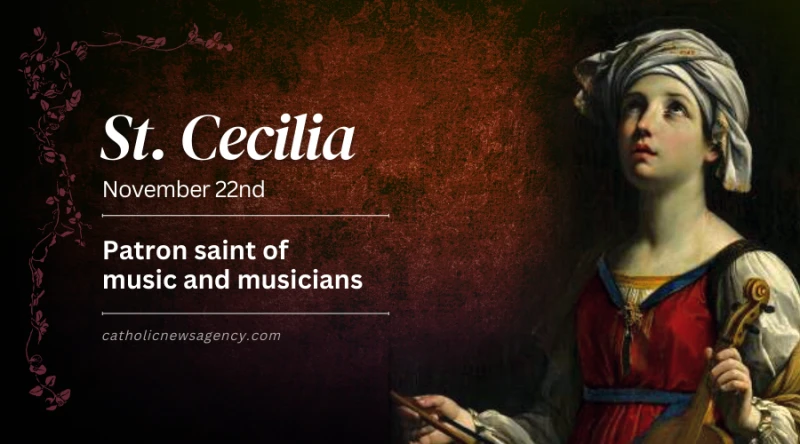
St. Cecilia
Feast date: Nov 22
St. Cecilia’s family was one of the principle families of Rome. According to the cultural custom of the time, Cecilia’s family betrothed her to a pagan nobleman named Valerian despite St. Cecelia’s consecration to God. On their wedding night, Cecilia told Valerian that she had sworn to remain a virgin before God and that an angel guarded her body, protecting her virginity from violation. She told Valerian that he would be able to see this angel if he went to the third milestone along the Via Appia and was baptized by Pope Urban I. Valerian went to the milestone as Cecilia had instructed, and there was baptized. She later converted his brother as well.
During that era, it was forbidden for anyone to bury the bodies of Christians, so newly-baptized Valerian and his brother dedicated themselves to burying the bodies of all the Christians they found. For this, they were arrested and brought before a judge who ordered them to worship the Roman god Jupiter, and were martyred when they refused to deny their Christian faith. The police then came for Cecilia and strongly advised her to renounce her faith. In reply, she told them that she would prefer to die than to denounce the true faith. According to legend, upon hearing her response, they brought her to a large oven with the intention of suffocating her with the hot and toxic gasses it emitted. However, instead of choking, Cecilia began to sing. Infuriated, her persecutors attempted to behead her, but after three strokes of the sword, Cecilia was still alive and her head was not severed. The soldiers then left her covered in blood in her own home, where she remained for three days before she died.
The church Santa Cecilia in Trastevere was built on the site of the house where she lived. St. Cecelia is known for “singing in her heart to the Lord” upon her wedding day, despite her consecration to God. She is the patron Saint of musicians and poets because of this sentiment and her alleged singing within the oven during her martyrdom. Her fortitude may inspire the modern Catholic in the trials of life and inspire one to find God within music.
Daily Reading
Second Sunday of Advent
Reading 1 Isaiah 11:1-10 On that day, a shoot shall sprout from the stump of Jesse, and from his roots a bud shall blossom. The spirit of the LORD shall…
Daily Meditation
Prepare the Way of the Lord
Click here for daily readings I remember going to Mass at my parish during Advent and hearing Father sing “Prepare Ye the Way of the Lord” (from the musical Godspell)…
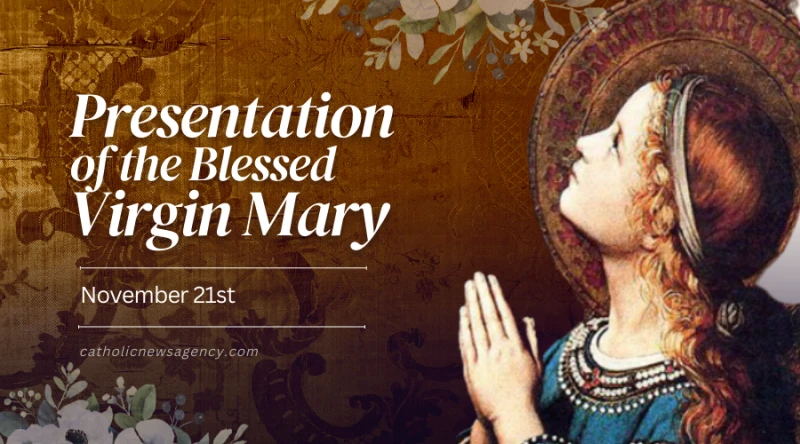
Feast of the Presentation of the Blessed Virgin Mary
Feast date: Nov 21
The Feast of the Presentation of the Blessed Virgin Mary, celebrated annually on November 21st, commemorates the presentation of the Blessed Virgin as a child by her parents in the Temple in Jerusalem. Before Mary’s birth, her parents received a heavenly message that they would bear a child. In thanksgiving for the God’s gift of Mary’s birth, they brought her to the Temple to consecrate their only daughter to The Lord.The celebration of the Feast is first documented in the 11th century within the Byzantine Catholic Church. It was introduced into the Roman Catholic Church in the 15th century by Pope Gregory XI, then removed from the calendar by Pope Pius V in the mid 16th century. Pope Sixtus V later reestablished the feast in 1585, and it is still celebrated today, commemorating the faith of her parents, Joachim and Anne, and the purity of Mary.
Daily Reading
Second Sunday of Advent
Reading 1 Isaiah 11:1-10 On that day, a shoot shall sprout from the stump of Jesse, and from his roots a bud shall blossom. The spirit of the LORD shall…
Daily Meditation
Prepare the Way of the Lord
Click here for daily readings I remember going to Mass at my parish during Advent and hearing Father sing “Prepare Ye the Way of the Lord” (from the musical Godspell)…

“Jesus entered the temple area and proceeded to drive out those who were selling things…” Most of us are familiar with this Gospel passage. It’s often used to point out that the Christian response to others is not always soft words, but sometimes righteous anger. Yet what is it really about and how does it relate to us?
I read a reflection once about this passage right before Christ drove the sellers out of the Temple: He braided a whip in preparation. Braiding a whip out of leather cords can take hours. Christ’s effort makes it clear that He prepared to cleanse the Temple. This was not an outburst of rage, nor a particularly bad day for Him. This was true justice in action.
What is justice? Is it taking out our anger on whoever is frustrating us? No, of course not. Perhaps we are rightfully angry with someone else for what they’ve done against us or others, or even against God. Perhaps it is in everyone’s best interest to share a few stern words in private. But no matter the circumstance, we are called to virtue, and that looks different in different situations, as Christ shows us here.
We know that He is the Man of perfect virtue. And justice is the virtue of giving to God and to others what they are owed. We owe God reverence, respect, obedience, and worship, to name a few. And we owe others charity, honesty, generosity, prudence, and so on.
The Temple was the Jews’ primary place of worship. In obedience to Old Testament laws, faithful Jews offered animal sacrifices when praying at the Temple – giving God His due. But the sellers here are deliberately taking advantage of those laws to make a profit. We know this because Christ condemns them as a “den of thieves.” Far, far worse than that, they are desecrating the Temple, stabling their smelly wares inside the sanctified walls of God’s holy house. Christ’s righteous anger is an act of restorative justice that amends the wrongs committed against God and others (the faithful Jews).
Our worship as Catholics today looks very different from that of ancient Judaism. Yet like the Jews, we also ought to give God and others what they are owed. The call of today’s Gospel is to turn inward to the temple of our God-given souls. Are you consistently giving God and others their due? Or is there an internal cleansing that needs to take place?
Take a few minutes out of your day and ask the Holy Spirit to open your eyes to the ways you have practiced justice toward God and others, and the ways you have fallen short. Then, take up the cords along with Christ, and accompany Him in the spiritual cleaning of your heart. The cords are painful, but they are also fruitful: we are restoring virtue and ultimately restoring our relationships with God and others.
Daily Reading
Second Sunday of Advent
Reading 1 Isaiah 11:1-10 On that day, a shoot shall sprout from the stump of Jesse, and from his roots a bud shall blossom. The spirit of the LORD shall…
Saint of the Day
St. Ambrose
St. Ambrose
Feast date: Dec 07
Today the Catholic Church celebrates the memory of St. Ambrose, the brilliant Bishop of Milan who influenced St. Augustine’s conversion and was named a Doctor of the Church. Like Augustine himself, the older Ambrose, born around 340, was a highly educated man who sought to harmonize Greek and Roman intellectual culture with the Catholic faith. Trained in literature, law, and rhetoric, he eventually became the governor of Liguria and Emilia, with headquarters at Milan. He manifested his intellectual gifts in defense of Christian doctrine even before his baptism. While Ambrose was serving as governor, a bishop named Auxentius was leading the diocese. Although he was an excellent public speaker with a forceful personality, Auxentius also followed the heresy of Arius, which denied the divinity of Christ. Although the Council of Nicaea had reasserted the traditional teaching on Jesus’ deity, many educated members of the Church – including, at one time, a majority of the world’s bishops – looked to Arianism as a more sophisticated and cosmopolitan version of Christianity. Bishop Auxentius became notorious for forcing clergy throughout the region to accept Arian creeds. At the time of Auxentius’ death, Ambrose had not yet even been baptized. But his deep understanding and love of the traditional faith were already clear to the faithful of Milan. They considered him the most logical choice to succeed Auxentius, even though he was still just a catechumen. With the help of Emperor Valentinan II, who ruled the Western Roman Empire at the time, a mob of Milanese Catholics virtually forced Ambrose to become their bishop against his own will. Eight days after his baptism, Ambrose received episcopal consecration on Dec. 7, 374. The date would eventually become his liturgical feast. Bishop Ambrose did not disappoint those who had clamored for his appointment and consecration. He began his ministry by giving everything he owned to the poor and to the Church. He looked to the writings of Greek theologians like St. Basil for help in explaining the Church’s traditional teachings to the people during times of doctrinal confusion. Like the fathers of the Eastern Church, Ambrose drew from the intellectual reserves of pre-Christian philosophy and literature to make the faith more comprehensible to his hearers. This harmony of faith with other sources of knowledge served to attract, among others, the young professor Aurelius Augustinus – a man Ambrose taught and baptized, whom history knows as St. Augustine of Hippo. Ambrose himself lived simply, wrote prolifically, and celebrated Mass each day. He found time to counsel an amazing range of public officials, pagan inquirers, confused Catholics and penitent sinners. His popularity, in fact, served to keep at bay those who would have preferred to force him from the diocese, including the Western Empress Justina and a group of her advisers, who sought to rid the West of adherence to the Nicene Creed, pushing instead for strict Arianism. Ambrose heroically refused her attempts to impose heretical bishops in Italy, along with her efforts to seize churches in the name of Arianism. Ambrose also displayed remarkable courage when he publicly denied communion to the Emperor Theodosius, who had ordered the massacre of 7,000 citizens in Thessalonica leading to his excommunication by Ambrose. The chastened emperor took Ambrose’s rebuke to heart, publicly repenting of the massacre and doing penance for the murders. “Nor was there afterwards a day on which he did not grieve for his mistake,” Ambrose himself noted when he spoke at the emperor’s funeral. The rebuke spurred a profound change in Emperor Theodosius. He reconciled himself with the Church and the bishop, who attended to the emperor on his deathbed. St. Ambrose died in 397. His 23 years of diligent service had turned a deeply troubled diocese into an exemplary outpost for the faith. His writings remained an important point of reference for the Church, well into the medieval era and beyond. St. Ambrose has been named one of the “holy fathers” of the Church, whose teaching all bishops should “in every way follow.”
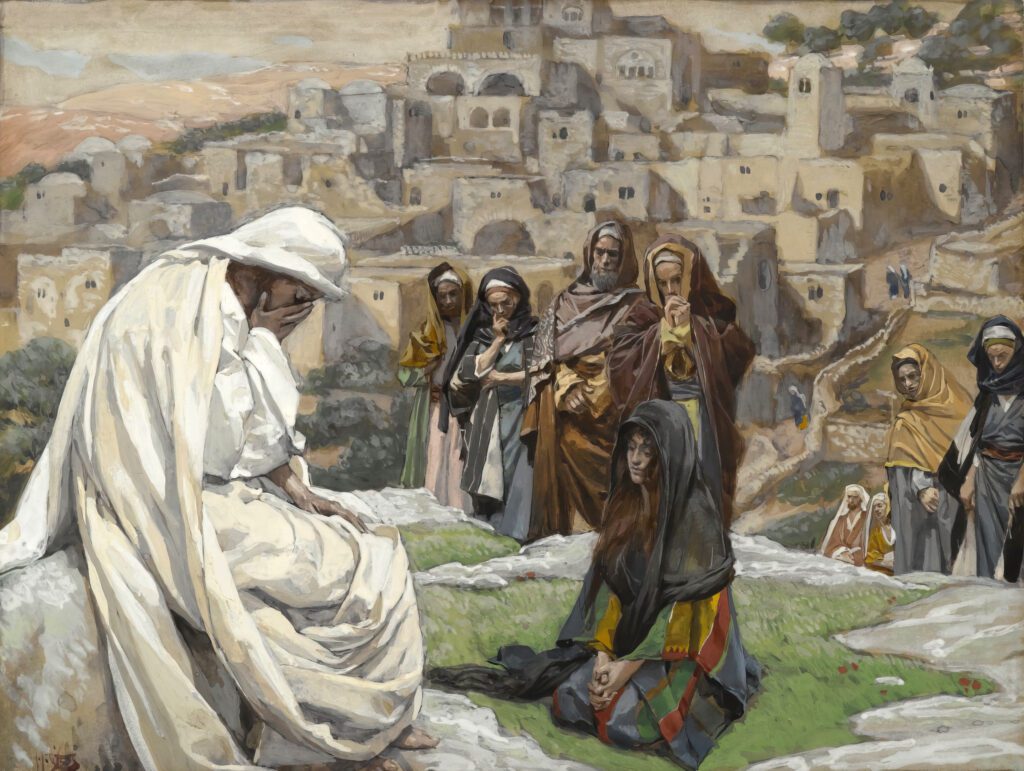
Way back in 1971, there was a TV movie called “The Homecoming: A Christmas Story.” It introduced the world to the Depression-era Walton family, which became a TV series a year or so later. One scene from the original movie always stuck with me: The Walton kids were teaching younger kids Bible verses at a Christmas Eve service, and those children would then recite the verses in order to receive a Christmas present. One Walton girl was feeding verses to a little boy, who would say, “That’s too long” or “I can’t remember that.” Finally, exasperated, the Walton daughter told the boy, “Jesus wept.” He ran to the minister, said those two words and happily accepted his gift.
Scripture tells us three times that Jesus shed tears. Hebrews Chapter 5 says, “In the days when he was in the flesh, he offered prayers and supplications with loud cries and tears to the one who was able to save him from death, and he was heard because of his reverence.”
In Chapter 11 of the Gospel of John, Jesus goes to raise Lazarus from the dead, and we are told, “When Jesus saw (Mary) weeping and the Jews who had come with her weeping, he became perturbed and deeply troubled, and said ‘Where have you laid him?’ They said to him, ‘Sir, come and see.’ And Jesus wept. So the Jews said, ‘See how he loved him.’”
Today’s Gospel, from Luke Chapter 19, gives us the third mention, during or just after his entry into Jerusalem on Palm Sunday: “As Jesus drew near Jerusalem, he saw the city and wept over it, saying, ‘If this day you only knew what makes for peace – but now it is hidden from your eyes.”
Jesus’ tears are because of His great love for those He loves, for those He came to save but reject His message, for the suffering that He must endure because of our sinfulness. I always think of that: Jesus came to suffer and die for me. Thanks be to God, but I’m the one who sinned in the first place that made it necessary. Jesus died for me, but Jesus also died because of me.
Are we still out here not recognizing the time of our visitation? Are we like the Jews in our first reading from Maccabees, sacrificing on the altar of our modern-day apostasies? Or are we like Mattathias when he invited others to follow the Lord saying, “Let everyone who is zealous for the law and who stands by the covenant follow after me!”?
Today’s readings make it a good day to ask God for the grace we need to have zeal for Him and His law, for His love and His truth, and for the role He has for us. May we not cause Him more tears, but rather love Him and serve Him in this life so that we can be with Him in true, unending joy in the life to come.
Daily Reading
Second Sunday of Advent
Reading 1 Isaiah 11:1-10 On that day, a shoot shall sprout from the stump of Jesse, and from his roots a bud shall blossom. The spirit of the LORD shall…
Saint of the Day
St. Ambrose
St. Ambrose
Feast date: Dec 07
Today the Catholic Church celebrates the memory of St. Ambrose, the brilliant Bishop of Milan who influenced St. Augustine’s conversion and was named a Doctor of the Church. Like Augustine himself, the older Ambrose, born around 340, was a highly educated man who sought to harmonize Greek and Roman intellectual culture with the Catholic faith. Trained in literature, law, and rhetoric, he eventually became the governor of Liguria and Emilia, with headquarters at Milan. He manifested his intellectual gifts in defense of Christian doctrine even before his baptism. While Ambrose was serving as governor, a bishop named Auxentius was leading the diocese. Although he was an excellent public speaker with a forceful personality, Auxentius also followed the heresy of Arius, which denied the divinity of Christ. Although the Council of Nicaea had reasserted the traditional teaching on Jesus’ deity, many educated members of the Church – including, at one time, a majority of the world’s bishops – looked to Arianism as a more sophisticated and cosmopolitan version of Christianity. Bishop Auxentius became notorious for forcing clergy throughout the region to accept Arian creeds. At the time of Auxentius’ death, Ambrose had not yet even been baptized. But his deep understanding and love of the traditional faith were already clear to the faithful of Milan. They considered him the most logical choice to succeed Auxentius, even though he was still just a catechumen. With the help of Emperor Valentinan II, who ruled the Western Roman Empire at the time, a mob of Milanese Catholics virtually forced Ambrose to become their bishop against his own will. Eight days after his baptism, Ambrose received episcopal consecration on Dec. 7, 374. The date would eventually become his liturgical feast. Bishop Ambrose did not disappoint those who had clamored for his appointment and consecration. He began his ministry by giving everything he owned to the poor and to the Church. He looked to the writings of Greek theologians like St. Basil for help in explaining the Church’s traditional teachings to the people during times of doctrinal confusion. Like the fathers of the Eastern Church, Ambrose drew from the intellectual reserves of pre-Christian philosophy and literature to make the faith more comprehensible to his hearers. This harmony of faith with other sources of knowledge served to attract, among others, the young professor Aurelius Augustinus – a man Ambrose taught and baptized, whom history knows as St. Augustine of Hippo. Ambrose himself lived simply, wrote prolifically, and celebrated Mass each day. He found time to counsel an amazing range of public officials, pagan inquirers, confused Catholics and penitent sinners. His popularity, in fact, served to keep at bay those who would have preferred to force him from the diocese, including the Western Empress Justina and a group of her advisers, who sought to rid the West of adherence to the Nicene Creed, pushing instead for strict Arianism. Ambrose heroically refused her attempts to impose heretical bishops in Italy, along with her efforts to seize churches in the name of Arianism. Ambrose also displayed remarkable courage when he publicly denied communion to the Emperor Theodosius, who had ordered the massacre of 7,000 citizens in Thessalonica leading to his excommunication by Ambrose. The chastened emperor took Ambrose’s rebuke to heart, publicly repenting of the massacre and doing penance for the murders. “Nor was there afterwards a day on which he did not grieve for his mistake,” Ambrose himself noted when he spoke at the emperor’s funeral. The rebuke spurred a profound change in Emperor Theodosius. He reconciled himself with the Church and the bishop, who attended to the emperor on his deathbed. St. Ambrose died in 397. His 23 years of diligent service had turned a deeply troubled diocese into an exemplary outpost for the faith. His writings remained an important point of reference for the Church, well into the medieval era and beyond. St. Ambrose has been named one of the “holy fathers” of the Church, whose teaching all bishops should “in every way follow.”



